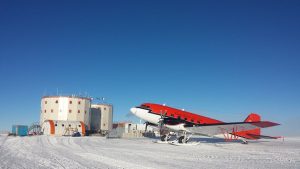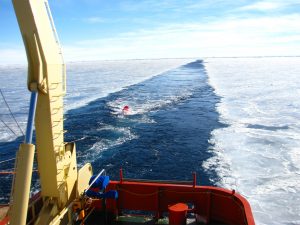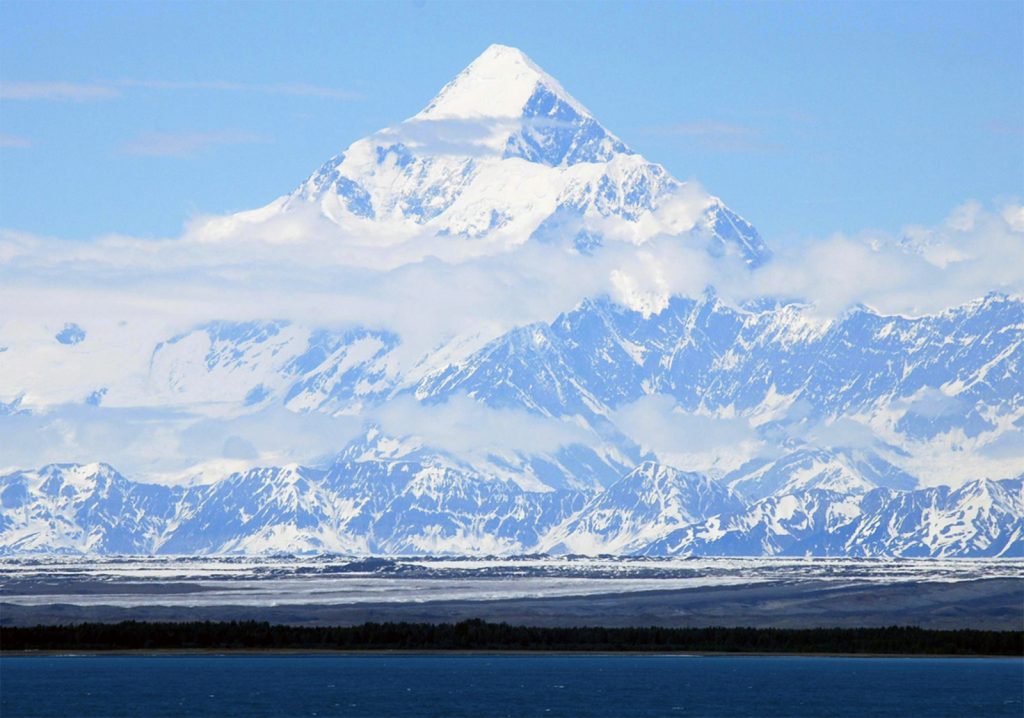Our researchers are engaged in field work around the world, below are a just a few of their ongoing projects.
Antarctic Old Ice

The Antarctic ice sheet preserves a key record of temperature and greenhouse gas concentration. The quest for a stratigraphic section of that record that extends into the mid-Pleistocene transition has been a primary goal on the international ice coring community. Since 2011, UTIG have been involved in a multi-pronged effort to identify and characterize parts of the ice sheet that may hold this ice. At Antarctica’s Concordia Station in 2016, Duncan Young led a high-resolution aerogeophysical survey to investigate a key candidate site termed “little Dome C.” Young also leads an investigation (funded by NSF as SPICECAP) of Titan Dome near South Pole, a primary target for US precursor rapid access drilling. Other future sites of interest from the old ice perspective include Ridge B and Dome Fuji. Importantly, there is a need for ice core duplication in order to trust the record deep in the ice sheet, so we need to assess multiple sites. Lucas Beem is leading the analysis, with Jamin Greenbaum coordinating ongoing data collection.
Ice-Ocean Interactions in East Antarctica
A key problem in Antarctic science is the coupling between the ocean and the ice sheet margin. For the last two years, UTIG’s ICECAP aerogeophysical collaboration with the Australian Antarctic Division and the French Polar Institute has focused on interactions between the ocean, grounding line, and subglacial hydrology at three critical locations in Wilkes Land, East Antarctica: Cook Ice Shelf, Totten Glacier, and the Shackleton Ice Shelf. We use ice penetrating radar and laser altimetry to constrain the subglacial hydrology and grounding zone, and gravity and magnetics, complemented with air deployed depth-temperature probes (AXBTs) to better understand the bathymetry for input into ocean models. This project is funded by NSF as EAGLE (East Antarctic Grounding Line Experiment). Donald Blankenship is the primary investigator, fieldwork has been led by Duncan Young, and analysis is led by Jamin Greenbaum.
Ice-Ocean Interactions in Greenland
Greenland’s mass balance is largely modulated by the changing dynamics of marine-terminating glaciers; however, there is currently no consensus as to what factors control this variability due to the lack of coincident ice-ocean-atmosphere data. In order to refine sea-level rise projections, a process-based understanding of the interactions between outlet glacier, atmosphere and ocean dynamics is necessary. In central west Greenland, adjacent marine-terminating glaciers exhibit contrasting temporal changes in ice speed, terminus position and mass flux. Ginny Catania’s research group investigates these processes using a variety of datasets: detailed in-situ ice, ocean and atmospheric measurements; ongoing airborne data collected through NASA’s Operation IceBridge campaign; and archival and current remote sensing and climate reconstructions. With the help of coupled numerical models to refine interpretation, these data will be used to identify the processes that control individual glacier variability. We anticipate our findings to be scalable – that is, they will help to understand, interpret, and predict mass balance and associated coupled dynamics for other ocean-terminating glaciers using historical and modern remote-sensing observations.
Ice Shelf Processes
Ice shelves are floating extensions of grounded glaciers that slow down the flow of the upstream ice masses. Hence, although ice shelves do not play a direct role into sea level rise since they are already floating onto the ocean, understanding their stability and, eventually, break-up is crucial to better estimate the future delivery rate of continental ice into the ocean. UTIG is leading numerous airborne investigations with radar sounders to unveil and characterize the surface, inner, and basal processes affecting ice shelves stability. Furthermore, ice shelves are also an incredible value to support future observations of icy moons that may host similar processes, such as Jupiter’s moon Europa and its ice-covered massive ocean. For example, the basal interface of the Totten ice Shelf, East Antarctica, as studied by Jamin Greenbaum, may be similar to that at Europa’s ice-ocean boundary, and could serve as analogs for understanding melting processes of Europa’s ice shell coupled with Krista Soderlund‘s models for ocean circulation. Similarly, brine infiltrations characterized by Cyril Grima at the McMurdo Ice Shelf, West Antarctica, are also a microbial habitat that represents important locations for the study of terrestrial extremophiles.
Greenland Ice Sheet Hydrology
The goal in this project is to examine the nature and cause of short-term ice velocity changes near Swiss Camp, Greenland. Our work will focus on the interactions between the ice sheet, the atmosphere and the bed through an integrated observational approach which involves borehole geophysics, surface-based GPS and modeling. We propose to: (1) measure changes in the subglacial water system over the summer season using a suite of borehole instrumentation; (2) measure the ice sheet response to changes in basal conditions with surface-based GPS, measured rates of borehole deformation and satellite data; (3) measure englacial and basal temperatures for input into flow models and to constrain estimates of ice deformation and; (4) correlate these data to melt and surface water volume proxies based on remote sensing data, meteorological data available from GC-Net and measured lake volume. For more information, contact Ginny Catania.
Temperate Glaciers
Temperate, subpolar glacial systems in Alaska, Greenland, and Patagonia have seen the greatest changes as the Earth warms under anthropogenic influence. At UTIG, we seek to understand glacial processes both in terms of ice dynamics and the interactions of marine terminating or tidewater glaciers with geology and the oceans. Active research exists in the role of glacial erosion producing sedimentary morainal banks and how these banks evolve and potentially stabilize tidewater glaciers. We seek to examine glacial history in context of glacial dynamics in key fjords in Alaska and Greenland in particular that provide a range of boundary conditions for this study. We study these processes through a combination of marine geology and geophysics and on-ice studies. For more information, contact Sean Gulick.
Margins and Fans of the Arctic and Antarctica

Continental margins and deep-sea fans provide a key record of glacial processes when adjacent to a glaciated margin or ice sheet. We have active programs studying the Cordilleran ice sheet in Alaska and Canada and the East Antarctic Ice Sheet offshore the Aurora and Wilkesland subglacial basins. Goals are to examine glacial history of these margins under polar and temperate climate regimes and how tectonic-glacial climate processes interact on timescales from individual advance retreat cycles to millions of years. Key techniques for these studies are seismic imaging of shelf records and deep-sea fans, ocean drilling, and integration with airborne and satellite observations. For more information, contact Sean Gulick.
Central Scotia Sea/South Georgia Island
RVIB Nathaniel B. Palmer Cruise 1408 [22 September to 22 October 2014] studied the impact of the Scotia Sea Floor and North Scotia Ridge on the onset and development of the Antarctic Circumpolar Current (ACC). The UTIG primary investigators, Ian Dalziel and Lawrence Lawver, worked with Robert Smalley Jr. of the Center for Earthquake Research and Information at the University of Memphis. The cruise had three specific scientific objectives: (1) Geophysical investigation of the tectonic nature of the northern and southern boundaries of the South Georgia microcontinent; (2) Installation of continuous Global Positioning System (cGPS) stations at three sites distributed around South Georgia; and (3) Targeted geophysical surveys in the unexplored zones of elevated crust in the eastern central Scotia Sea (CSS) with dredging for follow‐up geochemistry and geochronology by our British colleagues. Two hypotheses with regard to the onset and development of the ACC were to be tested; the first: the topographic highs of the CSS are all part of an extensive ancestral submerged volcanic arc that would have served as a barrier to the flow of the ACC even after opening of a deep ocean gateway between South America and the Antarctic Peninsula in Drake Passage and the west Scotia Sea (WSS). And the second hypothesis: The South Georgia microcontinent collided with the Northeast Georgia Rise beginning at ~10 Ma, altering pathways for a developing ACC and starting a process in which the South Georgia microcontinent is transferring to the South American plate with the development of the plate boundary on the southern side of the microcontinent. While substantial data were collected, severe weather restricted some of our goals. The three GPS sites installed in extremely inaccessible locations continue to send valuable data. Work is progressing on the seismic interpretations.
Impact Craters

Impact cratering is the dominant process affecting planetary surfaces on most rocky planets. At UTIG, we have an active program study impact processes particularly at the Chicxulub crater in the Yucatan, Mexico. Our interests include planetary resurfacing, how impacts weaken rocks and change their physical properties, relation of impact events to mass extinction (particular the end Cretaceous) and recovery of life afterwards, effects of the K-Pg impact on the Gulf of Mexico, and astrobiology of impact craters as crucibles for life. Most recently, UTIG has co-led the International Ocean Discovery Program expedition to drilling the Chicxulub impact crater (Exp. 364). We examine these processes through a full suite of geological and geophysical techniques. For more information, contact Sean Gulick.

